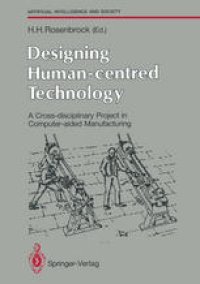
Ebook: Designing Human-centred Technology: A Cross-disciplinary Project in Computer-aided Manufacturing
- Tags: Computer-Aided Engineering (CAD CAE) and Design, Artificial Intelligence (incl. Robotics), Control Robotics Mechatronics, Engineering Economics Organization Logistics Marketing
- Series: The Springer Series on Artificial Intelligence and Society
- Year: 1989
- Publisher: Springer-Verlag London
- Edition: 1
- Language: English
- pdf
This second book in our series Artificial Intelligence and Society explores the issues involved in the design and application of human-centred systems in the manufacturing area. At first glance it may appear that a book on this topic is somewhat peripheral to the main concerns of the series. In fact, although starting from an engineering perspective, the book addresses some of the pivotal issues confronting those who apply new technology in general and artificial intelligence (AI) systems in particular. Above all, the book invites us to consider whether the present applications of technology are such as to make the best use of human skill and ingenuity and at the same time provide for realistic and economically sustainable systems design solutions. To do so it is necessary to provide systems which support the skill, and are amenable to the cultures, of the areas of application in question. In a philosophical sense it means providing tools to support skills rather than machines which replace them, to use Heidegger's distinction. The book gives an authoritative account of the University of Manchester Institute of Science and Technology (UMIST) tradition of human-centredness and provides a participatory design ap proach which focuses on collaborative learning and enhancement and creation of new skills. It also argues that collaboration should be supported by institutions through the creation of supportive infrastructures and research environments. It emphasises the optimisation of practical knowledge with the help of scientific knowledge and rejects the alternative.
The development of new technology is usually carried out by engineers, computer scientists and the like, having a background in the "hard sciences". When the resulting systems are found to be unsatisfactory for those who work with them, social scientists may be called upon to redesign jobs and working conditions. Only rarely is a sociotechnical approach employed, in which social and technical aspects are considered simultaneously. When it is, the details of the technology are usually not called into question, but only such matters as which of several commercially-available technologies should be used. The book describes an attempt to overcome this artificial and damaging separation of the technical and the human aspects of a new technology. A team comprising engineers, computer scientists, and a social scientist set out to develop jointly a human-centred machining system "in which operators are not subordinate to machines". The problems which arose from this cooperation are frankly discussed by those involved in the work and in its management. Many lessons, and some encouragement can be drawn by others wishing to follow a similar path.
The development of new technology is usually carried out by engineers, computer scientists and the like, having a background in the "hard sciences". When the resulting systems are found to be unsatisfactory for those who work with them, social scientists may be called upon to redesign jobs and working conditions. Only rarely is a sociotechnical approach employed, in which social and technical aspects are considered simultaneously. When it is, the details of the technology are usually not called into question, but only such matters as which of several commercially-available technologies should be used. The book describes an attempt to overcome this artificial and damaging separation of the technical and the human aspects of a new technology. A team comprising engineers, computer scientists, and a social scientist set out to develop jointly a human-centred machining system "in which operators are not subordinate to machines". The problems which arose from this cooperation are frankly discussed by those involved in the work and in its management. Many lessons, and some encouragement can be drawn by others wishing to follow a similar path.
Content:
Front Matter....Pages I-XVI
The Background to the Project....Pages 1-15
The Technical Problem....Pages 17-35
Towards a Design Methodology: A Psychologist’s View....Pages 37-50
The Social and Engineering Design of Computer Numerically Controlled Technology....Pages 51-64
A Computer Science View....Pages 65-80
On the Collaboration Between Social Scientists and Engineers....Pages 81-97
(How) Can Technology be Redirected? A Scandinavian Perspective....Pages 99-116
A Works Director’s View....Pages 117-121
The Coordinator’s View....Pages 123-131
Human-centred Systems....Pages 133-143
The ESPRIT Project....Pages 145-168
Postscript....Pages 169-172
Back Matter....Pages 173-208
The development of new technology is usually carried out by engineers, computer scientists and the like, having a background in the "hard sciences". When the resulting systems are found to be unsatisfactory for those who work with them, social scientists may be called upon to redesign jobs and working conditions. Only rarely is a sociotechnical approach employed, in which social and technical aspects are considered simultaneously. When it is, the details of the technology are usually not called into question, but only such matters as which of several commercially-available technologies should be used. The book describes an attempt to overcome this artificial and damaging separation of the technical and the human aspects of a new technology. A team comprising engineers, computer scientists, and a social scientist set out to develop jointly a human-centred machining system "in which operators are not subordinate to machines". The problems which arose from this cooperation are frankly discussed by those involved in the work and in its management. Many lessons, and some encouragement can be drawn by others wishing to follow a similar path.
Content:
Front Matter....Pages I-XVI
The Background to the Project....Pages 1-15
The Technical Problem....Pages 17-35
Towards a Design Methodology: A Psychologist’s View....Pages 37-50
The Social and Engineering Design of Computer Numerically Controlled Technology....Pages 51-64
A Computer Science View....Pages 65-80
On the Collaboration Between Social Scientists and Engineers....Pages 81-97
(How) Can Technology be Redirected? A Scandinavian Perspective....Pages 99-116
A Works Director’s View....Pages 117-121
The Coordinator’s View....Pages 123-131
Human-centred Systems....Pages 133-143
The ESPRIT Project....Pages 145-168
Postscript....Pages 169-172
Back Matter....Pages 173-208
....